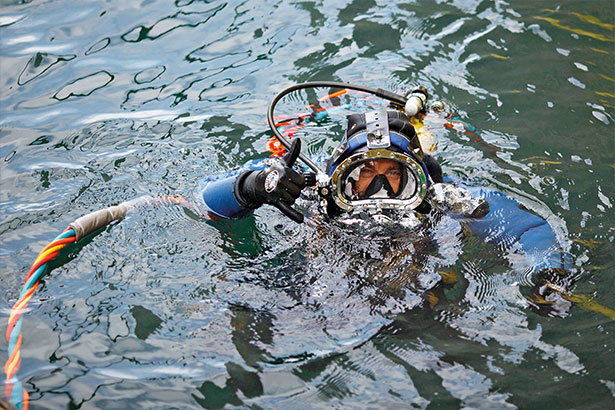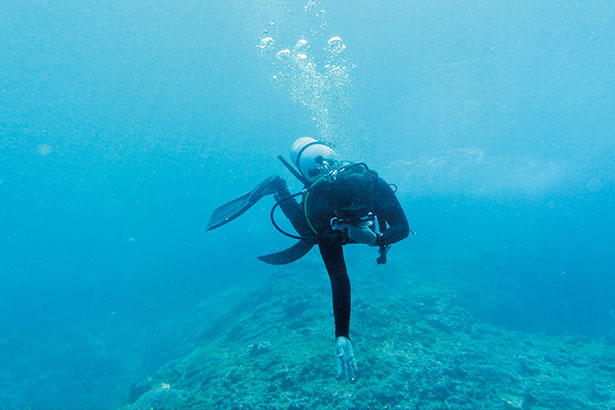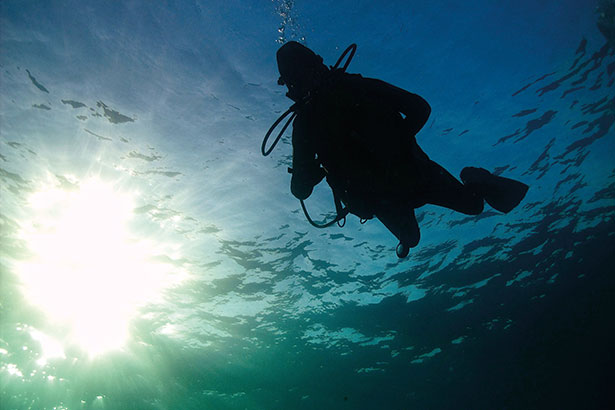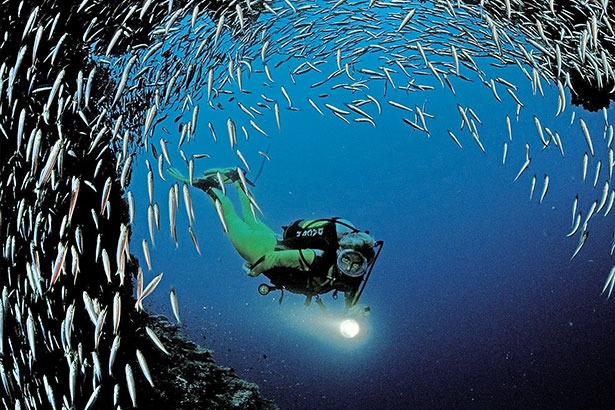We’re surrounded by it day in and day out, but how many of us have actually explored the deep blue sea?
Since Jacques Cousteau developed the Self-Contained Underwater Breathing Apparatus (SCUBA) in 1943, diving enthusiasts have explored a wondrous world of nature and wildlife from coast to coast. Lebanon is teeming with dive sites from French submarines to a stingray reef. Here’s what you need to know about scuba diving before heading out to open waters.
Training
Scuba diving requires proper training and a certificate from a reputable organization. Luckily Lebanon is considered an international diving spot with several accredited centers. Certified instructors, who teach theory and practical application both in a pool and open water, conduct courses.
If you are a fair swimmer and feel comfortable swimming underwater, you should be able to take the course. Divers must be in good physical health or have written permission from their doctor. The minimum age requirement is 12 if you are seeking an international certificate: PADI (Professional Association of Diving Instructors), NAUI (National Association of Underwater Instructors), TDI (Technical Diving International) and IANTD (International Association of Nitrox & Technical Diving), but some centers accommodate young divers with specialized lessons.
The Open Water Scuba Diver course from the National Institute for Scuba Diving is an IANTD program that offers three theory sessions and seven dives with a maximum diving depth of 18 meters. Included in the course are a complementary book, logbook and wall certificate, all scuba equipment during pool and sea sessions, beach entrance, international license as well as insurance coverage throughout the course. With your certificate in hand, Lebanon’s coast will have twice as much to offer.
Essential Equipment
For first-time divers eager to get back into the water after earning their license and wanting to purchase their own gear instead of renting, do make sure everything fits properly and is comfortable so you can focus on your dive and not the equipment.
Here’s what you need and what’s cool to have:
- Wetsuit: It will keep you warm especially when diving in cooler waters. You can add a weight system, either a weight belt or an integrated belt to help you sink.
- Mask: make sure it’s a perfect fit.
- Fins: Allow you to swim faster and easier underwater – there’s a wide variety, so choose one that works for you.
- BCD (Buoyancy Control Device): The jacket that allows you to float and control your depth.
- Cylinder: The tank that carries the air.
- Regulator: What you use to breathe the air from the tank.
- SPG (Submersible Pressure Gauge): Measures how much air is left in your tank.
- Depth gauge: Tells you how deep you are.
- Compass: Comes in handy when you need to know where you are and where to go.
Dive sites in Lebanon
Here is an essential guide for divers of all levels of experience compiled by Walid Noshie, owner of Water Nation and the National Institute of Scuba Diving.

AUB Canyon
AUB Canyon was one of the best diving spots known in the ’60s. It used to be called the Sharks hole since fishermen used to catch sharks from the deep end of the canyon. Nowadays, sharks are almost nonexistent on that spot. The walls on this reef are steep, beautiful, full of small caves and fishermen’s nets, with a huge old anchor lying at 43m.
- Location: Facing American University Beach
- Condition: Rocky but easy entry, rocky bottom. Some wind and waves are possible, watch out for sea urchins on entry.
- Depth of dives: Rocky sea bottom starts at 5m, drop-offs down to more than 300m
- Level: Beginner to advanced.
- Quality of marine life: Diverse; moray eels, octopus and groupers; lobsters in April.
- Visibility: 6-20m, rain and river run-off affect visibility. Excellent spot for night diving when visibility is good, all marine life out of the rocks feeding, including flute fish, stingrays, and Spanish dancers.
Shark Point
Shark point is an area composed of 5 reefs, which includes some plateau sections and a deep canyon running along every reef towards the east. Crossing one reef to the other towards the north are sand beds in between, making the passages look like huge corridors. At the third reef, divers will admire a statue of a Lebanese saint praying above a small cave in which stingrays take refuge. At the 4th reef is a vertical wall with a rugged profile full of fissures, inlets and crevices to explore. The 5th reef towards the East is where most sharks are observed.
- Location: 1.5km southwest of Raouche.
- Condition: Strong wind, waves, and currents are possible.
- Depth of dives: Rocky bottom starts at 28m, drops to 50m.
- Level: Experienced and Advanced.
- Quality of marine life: Diverse and rich. Best in the whole country especially between April and September. Moray eels, stingrays in groups, eagle rays, groupers but best of all are the sharks – the small Tooth Sand Tiger and the Gray Nurse sharks – which will start showing up in July and disappear again in October.
- Visibility: 10-25m, good all year round although affected by currents and plankton blooms.
The “Souffleur”
The “Souffleur” can be ranked among one of the best WWII wrecks in the world. It is a French submarine, which sank in battle, badly damaged and cut in two, but virtually intact. Divers will find plenty of open holes from fishermen dynamiting the site for fish. They look very tempting to discover, but beware of narrow passages and silt that will immediately cover your trace, making entry extremely hazardous.
- Location: 12km south of Ras-Beirut.
- Condition: Current, waves and wind can be considerable.
- Depth of dive: Average 34m to a maximum of 38m.
- Level: Experienced and advanced.
- Quality of marine life: Diverse. Stingrays, moray eels and eagle rays.
- Visibility: 6-25m year-round affected by currents and plankton blooms.
The “Macedonia”
The “Macedonia” was a cargo ship sailing regularly between Egypt and Lebanon in the early 1960’s. On a stormy night, sailing too close to shore, Macedonia hit the shallow reef off Raouche making a huge hole in its entire front lower hull. The wreck split in two, one part on the sandy side of the reef and the other on the rocks. It is fairly well colonized by different species of fish, including groupers and lobsters in the spring.
- Location: 500m northwest of Raouche.
- Condition: Currents can be considerable.
- Depth of dive: Average 12m to a maximum of 17m.
- Level: Beginner to advanced.
- Quality of marine life: Good density and diversity of schools of fish, moray eels, and octopus.
- Visibility: 8-20m, best in April and May.
The Tunnels
The Tunnels are a crack in the rocks towards the west, 7m wide and 100m in length, which make it look like a passage between two walls. Marine life is pleasant with a reef fish population that seems concentrated on this small spot due to favorable conditions.
- Location: northwest of Raouche, 100m west of the wreck “Macedonia”.
- Condition: Currents and waves can be considerable.
- Depth of dive: Average 15m to a maximum of 20m.
- Level: Beginner to advanced.
- Quality of marine life: Diverse. Moray eels, octopus, groupers as well as turtles.
- Visibility: 6-20m north wind will reduce visibility and produce strong currents.

Stingray Reef
The dive site encompasses a wide, oval sloping patchy reef that extends to the west of the circular reef top. The reef composition is quite varied, with patchy sections in sand beds. Fish life is not great, but in June and July, the sand beds and reef bottom crevices will surprise you throughout the haul dive. It is not unusual for divers to encounter as many as 10 rays in a single dive. From stingrays to electric rays to Thornback rays and even eagle rays. The reef slope is suitable for relatively inexperienced divers while more experienced divers will enjoy the incredible experience of seeing such a diversity of rays.
- Location: 500m northwest from the military beach of Beirut.
- Condition: Possibility of wind and waves on the surface.
- Depth of dive: Average 22m to a maximum of 31m.
- Level: Experienced and Advanced.
- Quality of marine life: Diversity of fish and rays.
- Visibility: 5-20m year-round affected by currents.
The “Alice B”
Alice B is not an old site but on a good visibility dive, it is very interesting and exceptionally photogenic for underwater photography divers. The ship is resting on the flat bottom, 38m from the surface. Starting at the main control room, the area is wide and accessible by most divers. It is advisable that divers be specialized in wreck penetration before attempting entry into the interior.
- Location: 1 km northwest of ATCL in Jounieh.
- Condition: Well protected, mild underwater current possible.
- Depth of dive: Average 34m to a maximum of 38m.
- Level: Advanced.
- Best time to dive: Year round in calm weather.
- Quality of marine life: Schools of tuna, groupers, and lobster.
- Visibility: 4m to 25m best on a very mild north wind.
Torpedo Carrier Boat
The name of this wreck remains a mystery. This ship was used as a Torpedo Carrier supplying the Vichy submarines with torpedoes in the open sea. The ship was sunk after receiving a direct hit either from an allied ship canon or bombed from an airplane. On a good visibility dive, it is very interesting and exceptionally photogenic for underwater photography divers with about 10 submarine torpedoes lying on the deck. The ship is resting on the flat bottom, 60m from the surface.
- Location: Tripoli, 4km facing the Fishing Port.
- Condition: Current, waves and wind can be considerable.
- Depth of dive: Average 60m to a maximum of 62m.
- Level: Experienced to advanced.
- Quality of marine life: Diverse marine life
- Visibility: 15 to 30m year-round affected by currents and plankton blooms.
HMS Victoria
The HMS Victoria was the flagship in the Mediterranean of Admiral Sir George Tryon. Part of the Victoria Class turret ship of the Royal Navy, the HMS Victoria was rammed and sunk by HMS Camperdown on the 22nd of June 1893. Admiral Tryon intended the maneuvers and the anchoring to be an impressive sight to the entire British Navy fleet, but unfortunately, the two battleships met halfway. Camperdown struck the Victoria on the flagship’s starboard side, opening up an enormous hole at and below the waterline. Victoria’s bow went down and the stern rose with the propellers still turning. Today, the HMS Victoria is resting at the bottom in a vertical position, with the stern pointing upward starting at 75 meters.
- Location: Tripoli, 16km northwest.
- Condition: Current, waves and wind can be considerable.
- Depth of dive: From 75m to 146m.
- Level: Experienced to Technical.
- Quality of marine life: Diverse marine life.
- Visibility: 15 to 30m year-round affected by currents and plankton blooms.
Article published on August 5, 2021.
Article edited on October 4, 2021.
Loading

